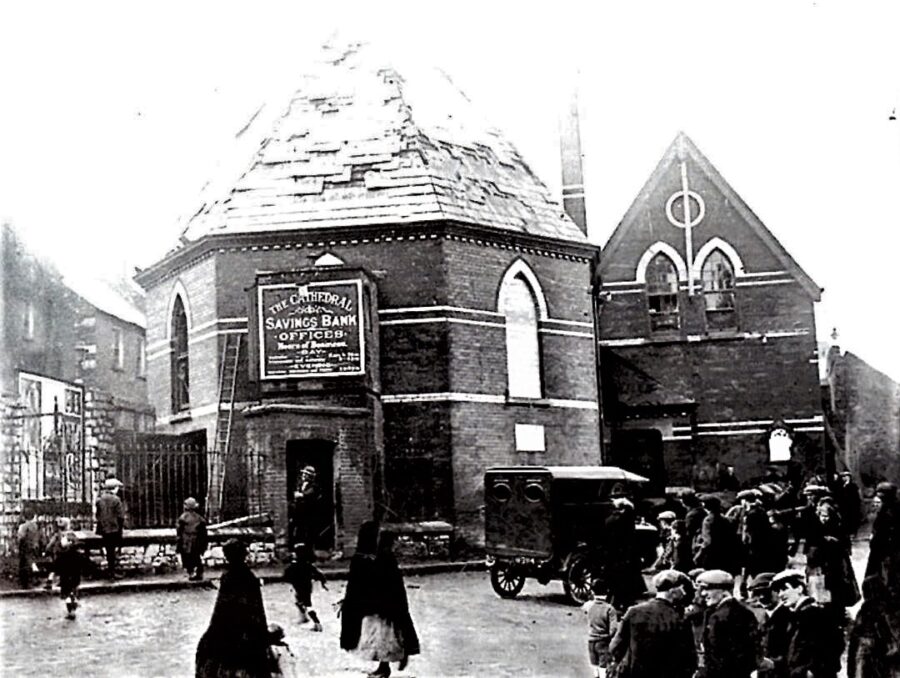
Kieran’s Our City, Our Town Article,
Cork Independent, 16 March 2023
Recasting Cork: The Bombing of St Mary’s Hall
Early Spring 1923 coincided with tit-for-tat skirmishes between Anti-Treaty republicans and the Irish Free State Government. Some skirmishes and events were more extreme than others. For example, on 2 March 1923 St Mary’s Hall, opposite the North Cathedral, was blown up by a land mine by Anti-Treaty IRA supporters. The bomb was attributed to the refusal on the part of those responsible for the management of the Hall to close on the occasion of another hunger strike by Mary MacSwiney’s in a Dublin jail. On that occasion all Cork houses of entertainment were ordered to close by Anti-Treaty Republicans. All did so with the exception of St Mary’s Hall.
The Cork Examiner records that at about 10am, four men, two of them wearing trench coats and hats, and two dark coloured colours coats and hats, drove up in a motor car from the Blackpool direction and stopped outside St Mary’s Hall opposite St Mary’s and St Anne’s North Cathedral. Entering the Hall, they ordered the woman engaged in cleaning the premises outside, where one of the men held her up at the point of the revolver. The other men apparently laid a land mine and left the building.
Immediately afterwards a terrific explosion occurred, which could be heard all over the city. The people in the area got a serious shock. Many were physically pulled to the ground by the force of the explosion. Glass and ware were broken in many houses.
At the North Cathedral across the road, where the 10am mass was in progress, some remained in their seats whilst others feared that it was the Cathedral itself that was being attacked made a rush for the doors. All soon returned though and the mass was proceeded with as if nothing had occurred. The same feeling of shock was felt in the nearby North Infirmary where patients feared for their lives.
The bomb caused serious damage to St Mary’s Hall. The Hall was an important community asset to the North Parish. The hall’s foundation stone on a plot of land off Bailey’s Lane was laid on 27 June 1887 by Bishop O’Callaghan and was opened on 20 November 1887. It replaced a smaller community hall within the North Parish on Eason’s Hill called St Mary’s League of the Cross Hall. The Cork Examiner on 22 November 1887 nods to the the untiring energy of the Rev. Canon John O’Mahony. Great credit was also given Mr J Coakley, the architect, and to Mr John McDonnell, the builder. The building was illuminated from the outside with gas jets representing a harp and shamrocks, and was also lit within, by the firm of Mr M Power & Son, Marlboro Street.
In October 1912 St Mary’s Hall was fitted out as a picture drome to host moving pictures or films. Hence by the bombing of March 1923 the building had four sections – it was a theatre where concerts and films were shown. On Sundays the children of the parish received religious instruction. It was also available for meetings of clubs and social parish work. A gallery had recently been constructed in the theatre, which aimed to host 1,000 people between the gallery and downstairs. The theatre was completely wrecked and the machinery connected with the cinema destroyed.
In the other portions of the building a savings bank for the parishioners, a penny savings bank for children, and the National Health Insurance business was conducted. Deposits in the ordinary savings bank amounted to about £35,000, and in the penny savings bank £2,000.
At least three persons were injured as a result of the explosion. An emergency exit door onto Bailey’s Lane was blown out and struck a Mrs O’Brien who lived in the area seriously injuring here. A boy named William Doyle was struck on the head by a flying slate, sustaining a nasty scalp wound for which he was treated at the North Infirmary. A girl, also on the way to school, was struck by a flying slate.
A soldier of the Irish Free State government on duty in the Butter Market district, ran at once to the scene and detained three men.
The Cork Examiner records that the raiders on planting the bomb then drove to the foot of Fair Hill where the car was found later and brought to the vicinity of St Mary’s Hall, where the military took possession of it. It was stated that the car was taken the previous night at 9pm from Murphy’s Brewery by armed men.
Two days later on the 4 March, the city’s Roman Catholic Bishop Daniel Cohalan began his sermon by condemning the bombing; “The Bishops of Ireland have on more than one occasion, declared the law about the activities of the Republicans against life and property…I condemn the outrage with all my heart. I convey my sympathy to the priests and the people of the Cathedral parish on the injury done to them. And I pray that the culprits and all engaged in the Republican physical force campaign may get the light to see the unlawfulness of this campaign and the grace to abandon it”.
St Mary’s Hall was quickly reconstructed in the weeks that followed the bombing and remained as a prominent community hall and picture drome until the late 1940s where the site and Bailey’s Lane was cleared as part of ongoing Cork Corporation slum clearance plans.
Caption:
1193a. St Mary’s Hall c.1920 (source: Shandon History Area Group; to learn about this great group and their talks, writings and poster displays, log onto their informative Facebook page).